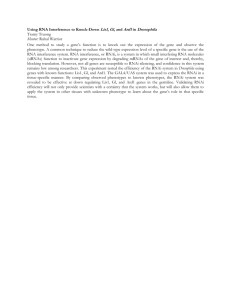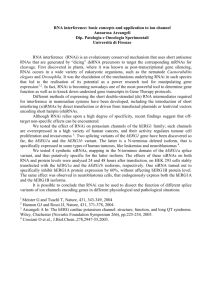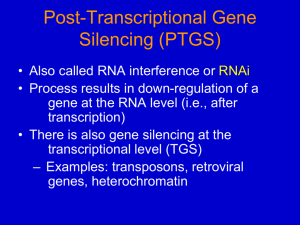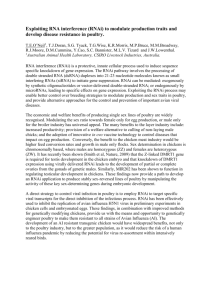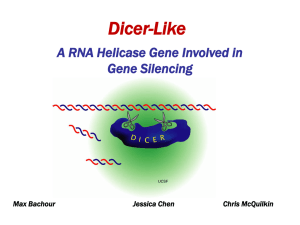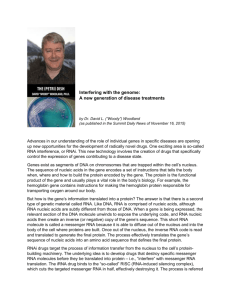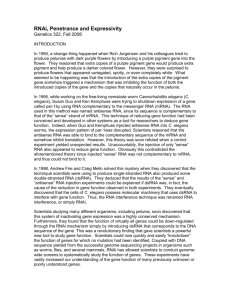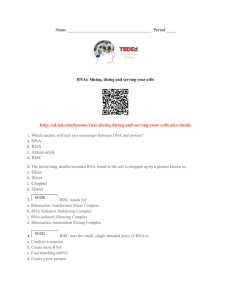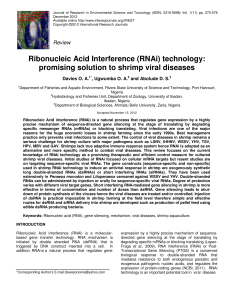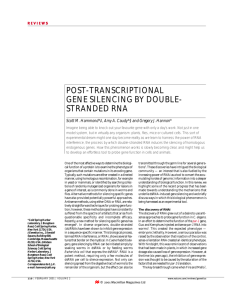RNAi - etsEQ
advertisement
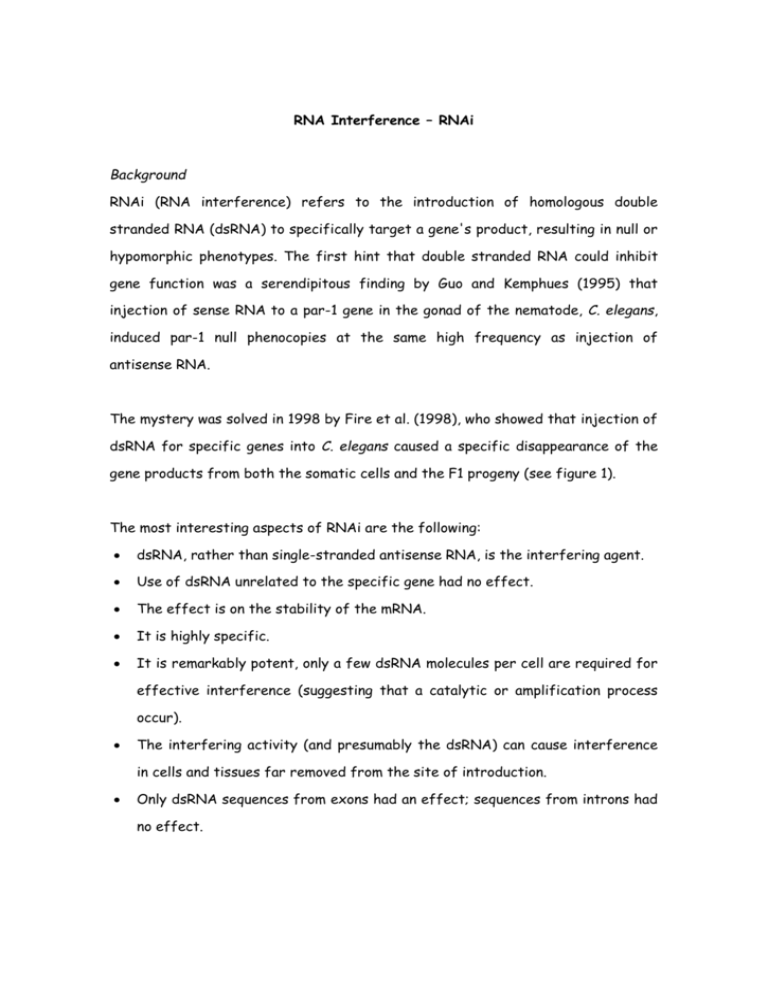
RNA Interference – RNAi
Background
RNAi (RNA interference) refers to the introduction of homologous double
stranded RNA (dsRNA) to specifically target a gene's product, resulting in null or
hypomorphic phenotypes. The first hint that double stranded RNA could inhibit
gene function was a serendipitous finding by Guo and Kemphues (1995) that
injection of sense RNA to a par-1 gene in the gonad of the nematode, C. elegans,
induced par-1 null phenocopies at the same high frequency as injection of
antisense RNA.
The mystery was solved in 1998 by Fire et al. (1998), who showed that injection of
dsRNA for specific genes into C. elegans caused a specific disappearance of the
gene products from both the somatic cells and the F1 progeny (see figure 1).
The most interesting aspects of RNAi are the following:
dsRNA, rather than single-stranded antisense RNA, is the interfering agent.
Use of dsRNA unrelated to the specific gene had no effect.
The effect is on the stability of the mRNA.
It is highly specific.
It is remarkably potent, only a few dsRNA molecules per cell are required for
effective interference (suggesting that a catalytic or amplification process
occur).
The interfering activity (and presumably the dsRNA) can cause interference
in cells and tissues far removed from the site of introduction.
Only dsRNA sequences from exons had an effect; sequences from introns had
no effect.
Figure 1. Effects of mex-3 RNA interference on levels of the endogenous mRNA.
Nomarski DIC micrographs show in situ hybridization of 4-cell stage embryos.
(A) Negative control showing lack of staining in the absence of the hybridization probe.
(B) Embryo from uninjected parent showing normal pattern of endogenous mex-3 RNA
(purple staining). (C) Embryo from parent injected with purified mex-3 antisense RNA.
These embryos (and the parent animals) retain mex-3 mRNA, although levels may be
somewhat less than wild type. (D) Late 4-cell stage embryo from a parent injected with
dsRNA corresponding to mex-3; no mex-3 RNA is detected. (Each embryo is approximately
50 µm in length).
RNAi in other systems
More surprisingly, introduction of dsRNA has been shown to produce specific
phenocopies of null mutations in such phylogenetically diverse organisms as:
Drosophila.
Protozoan (Trypanosomes).
Zebrafish.
Mice.
Planaria.
Plants.
Mechanism of RNAi
A number of observations indicate that the primary interference effects are
post-transcriptional. First it was observed by Craig Mello and reported in Fire et
al. ('98) that only dsRNA targeting exon sequences was effective (promoter and
intron sequences could not produce an RNAi effect). Additional evidence
supporting mature messages as the most likely target of RNA-mediated
interference is summarised below (from Montgomery et al. 1998).
Primary DNA sequence of target appears unaltered
Initiation and elongation of transcription appear unaffected
Nascent transcripts can be detected but are apparently degraded before
leaving the nucleus
Because RNAi is also remarkably potent (i.e., only a few dsRNA molecules per cell
are required to produce effective interference), the dsRNA must be either
replicated and/or work catalytically. The current model favors a catalytic
mechanism by which the dsRNA unwinds slightly, allowing the antisense strand to
base pair with a short region of the target endogenous message and marking it for
destruction. "Marking" mechanisms could involve covalent modification of the
target (e.g. by adenosine deaminase) or any number of other mechanisms.
Potentially, a single dsRNA molecule could mark hundreds of target mRNAs for
destruction before it itself is "spent."
Montgomery et al. (1998). Found that the primary DNA sequence remained
unchanged after obtaining a strong twitching phenotype in the F1 progeny by
injecting dsRNA for a segment of the unc-22 gene in C. elegans. They also
examined the lin-15 operon which consists of lin-15b and lin-15a; disruption of
either gene has no effect whereas disruption of both produced a multivulva (MIV)
phenotype. Likewise, RNAi against only one gene had no effect but RNAi against
both produced the MIV phenotype. This argued that the primary target in RNAi
was not the initiation or elongation of transcription. This work led to the following
model:
Figure 2. Possible model for dsRNA-mediated genetic interference in C. Elegants Upon
introduction into the cell, dsRNA is proposed to complex with a (hypotetical) protein or
ribonucleoprotein that allows unwinding of an arbitrary segment of the duplex.
RNA Interference and Gene Silencing
Post-transcriptional gene silencing (PTGS), which was initially considered a bizarre
phenomenon limited to petunias and a few other plant species, is now one of the
hottest topics in molecular biology. In the last few years, it has become clear that
PTGS occurs in both plants and animals and has roles in viral defense and
transposon silencing mechanisms. Perhaps most exciting, however, is the emerging
use of PTGS and, in particular, RNA interference (RNAi) — PTGS initiated by the
introduction of double-stranded RNA (dsRNA) — as a tool to knock out expression
of specific genes in a variety of organisms.
Background
More than a decade ago, a surprising observation was made in petunias. While
trying to deepen the purple color of these flowers, Rich Jorgensen and colleagues
introduced a pigment-producing gene under the control of a powerful promoter.
Instead of the expected deep purple color, many of the flowers appeared
variegated
or
even
white.
Jorgensen
named
the
observed
phenomenon
"cosuppression", since the expression of both the introduced gene and the
homologous endogenous gene was suppressed.
First thought to be a quirk of petunias, cosuppression has since been found to
occur in many species of plants. It has also been observed in fungi, and has been
particularly well characterized in Neurospora crassa, where it is known as
"quelling".
Although transgene-induced silencing in some plants appears to involve genespecific methylation (transcriptional gene silencing, or TGS), in others silencing
occurs at the post-transcriptional level (post-transcriptional gene silencing, or
PTGS). Nuclear run-on experiments in the latter case show that the homologous
transcript is made, but that it is rapidly degraded in the cytoplasm and does not
accumulate.
Introduction of transgenes can trigger PTGS, however silencing can also be
induced by the introduction of certain viruses. Once triggered, PTGS is mediated
by a diffusible, trans-acting molecule. This was first demonstrated in Neurospora,
when Cogoni and colleagues showed that gene silencing could be transferred
between nuclei in heterokaryotic strains. It was later confirmed in plants when
Palauqui and colleagues induced PTGS in a host plant by grafting a silenced
transgene-containing source plant to an unsilenced host. From work done in
nematodes and flies, we now know that the trans-acting factor responsible for
PTGS in plants is dsRNA.
The Biochemical Mechanism of RNAi
So how does injection of dsRNA lead to gene silencing? Many research groups
have diligently worked over the last few years to answer this important question.
A key finding by Baulcombe and Hamilton provided the first clue. They identified
RNAs of ~25 nucleotides in plants undergoing cosuppression that were absent in
non-silenced plants. These RNAs were complementary to both the sense and
antisense strands of the gene being silenced.
Further work in Drosophila — using embryo lysates and an in vitro system derived
from S2 cells — shed more light on the subject. In one series of experiments,
Zamore and colleagues found that dsRNA added to Drosophila embryo lysates was
processed to 21-23 nucleotide species. They also found that the homologous
endogenous mRNA was cleaved only in the region corresponding to the introduced
dsRNA and that cleavage occurred at 21-23 nucleotide intervals. Rapidly, the
mechanism of RNAi was becoming clear.
Current Models of the RNAi Mechanism
Both biochemical and genetic approaches have led to the current models of the
RNAi mechanism. In these models, RNAi includes both initiation and effector
steps
(see
a
flash
animation
of
“How
does
RNAi
works”
at
http://www.nature.com/nrg/journal/v2/n2/animation/nrg0201_110a_swf_MEDIA1
.html).
In the initiation step, input dsRNA is digested into 21-23 nucleotide small
interfering RNAs (siRNAs), which have also been called "guide RNAs". Evidence
indicates that siRNAs are produced when the enzyme Dicer, a member of the
RNase III family of dsRNA-specific ribonucleases, processively cleaves dsRNA
(introduced directly or via a transgene or virus) in an ATP-dependent, processive
manner. Successive cleavage events degrade the RNA to 19-21 bp duplexes
(siRNAs), each with 2-nucleotide 3' overhangs.
In the effector step, the siRNA duplexes bind to a nuclease complex to form what
is known as the RNA-induced silencing complex, or RISC. An ATP-depending
unwinding of the siRNA duplex is required for activation of the RISC. The active
RISC then targets the homologous transcript by base pairing interactions and
cleaves the mRNA ~12 nucleotides from the 3' terminus of the siRNA. Although
the mechanism of cleavage is at this date unclear, research indicates that each
RISC contains a single siRNA and an RNase that appears to be distinct from
Dicer.
Because of the remarkable potency of RNAi in some organisms, an amplification
step within the RNAi pathway has also been proposed. Amplification could occur by
copying of the input dsRNAs, which would generate more siRNAs, or by replication
of the siRNAs themselves. Alternatively or in addition, amplification could be
effected by multiple turnover events of the RISC.
Homework done by: Camilo Mancera Arias
